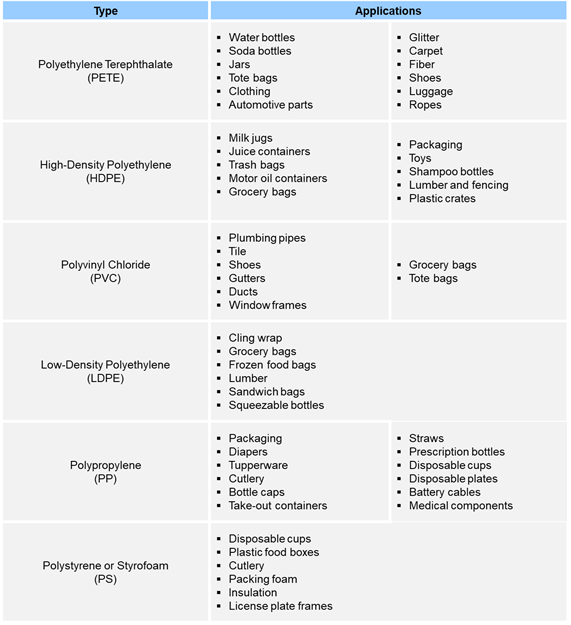Growing concerns from environmentalist consumers, and businesses, China’s ban on imported recyclables, and a lack of a domestic market for U.S. recyclables are driving efforts to reduce plastic waste. Plastics have been an essential component of our daily lives for many years as they are used in countless items we use everyday. Applications and top producers for the six key plastics are described in Figure 1.

Figure 1: Six Key Types of Plastics
On January 2018, China stopped being the end destination for dozens of foreign recyclable materials including plastics. Exporting countries either used this as an opportunity to either improve domestic recycled infrastructure, become an importer themselves, or seek ways to reduce waste domestically. Up until this point, China had been receiving ~40% of U.S. recyclables and now cities across the U.S. are struggling to adapt to the ban as many domestic facilities are not able to meet the clean and unmixed standards. Many cities across the U.S. are also scaling back or eliminating their recycling programs due to capacity constraints and financial losses.
As an alternative to recycling plastics, many are pushing to eliminate single use or disposable plastics which are used only once before they are thrown away or recycled. Examples of single use plastics include straws, cups, glitter, cutlery, and grocery bags. Local governments within the U.S. have already begun proposing and enacting legislation to eliminate the use of these items. Currently only California, Hawaii, and now New York have statewide plastic bag bans, but many cities have begun adopting similar policies. Large companies such as Starbucks, Hyatt, and Marriott have begun announcing their shift away from plastic straws and several cities have announced the same. As adoption of these policies increases, the plastics industry will likely face challenges going forward.
Plastics impacted by these changes in the long term include PET (glitter), HDPE (grocery bags), LDPE (grocery bags), PP (cutlery, straws, disposable cups), and PS (cutlery and disposable cups). While many of these end uses are not primary drivers of demand in their respective plastic category, the decline in use in the U.S. and Europe will have a negative impact on plastics and subsequently oil markets as they are petroleum products. The U.S. largely drives demand for single use plastics and its shift away from such products will significantly reduce demand in the long term.
There are alternatives such as using compostable, biodegradable, or bio-based plastics which are made by taking sugars derived from plants and converting them into raw materials which can be formed into plastic resins. Some retailers further downstream have begun investing in bio-based plastics. For example, Coca-Cola has introduced “PlantBottle”, a plastic bottle packaging made up of 30% plant-based materials. While a steep decline in single use plastics is many years away, plastic producers should start preparing themselves and making significant investments in academic research and advanced material manufacturing startups to meet the growing demand of tomorrow as the need for straws, cups, glitter, cutlery, and grocery bags will only increase as the population grows. Brandon Johnson
— Brandon Johnson

